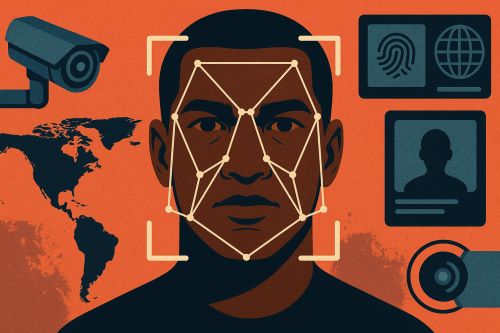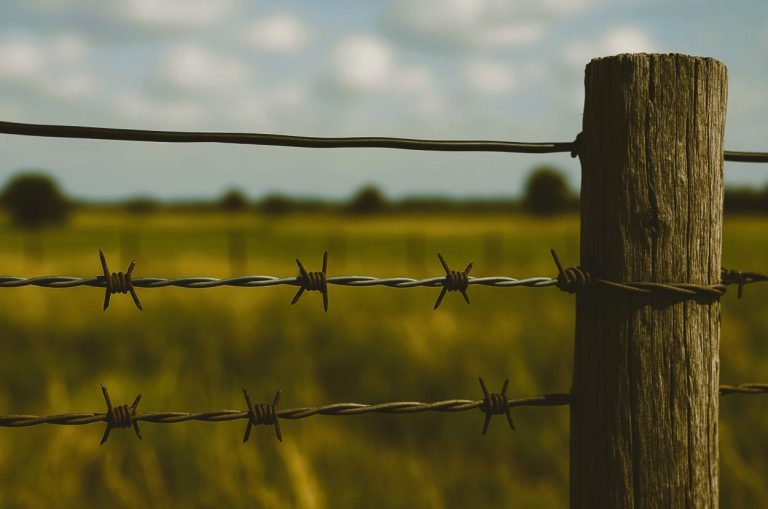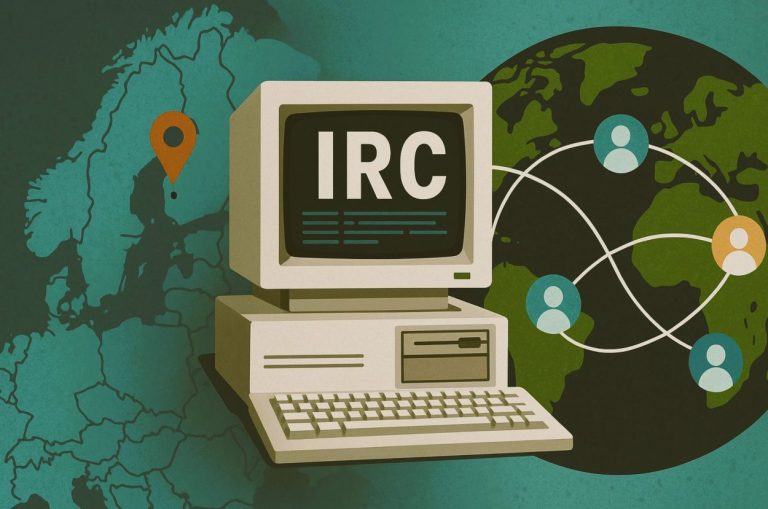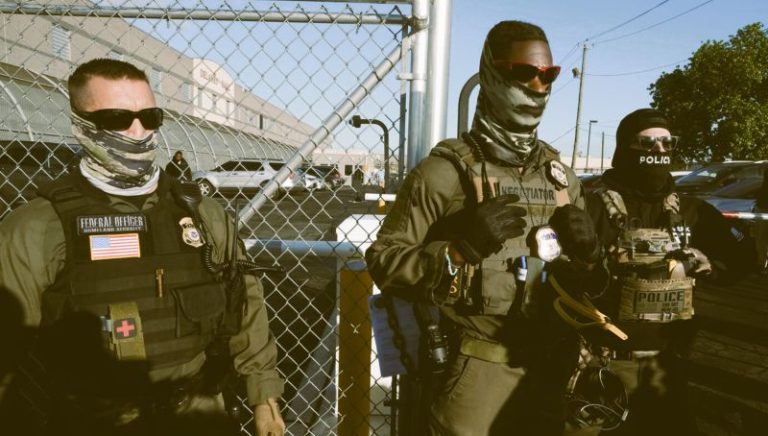

In the drive to catalog every face, every breath, every blink, we risk losing something human, something fragile, unquantifiable, and sacred.

By Matthew A. McIntosh
Public Historian
Brewminate
Introduction: The Eyes of the State
In an era when facial recognition unlocks phones, authenticates bank transactions, and tracks our movements in public spaces, one question looms large: who owns your face? The answer is increasingly complicated. As China, India, and the United States race to build the most expansive biometric databases on Earth, a quiet battle is underway, not for territory or arms, but for dominion over identity itself.
This is not science fiction. The contours of power are changing, defined not by borders or bombs but by patterns of iris scans and heat signatures. In this unfolding global order, biometric data (faces, fingerprints, DNA) is both currency and weapon. It offers promise, peril, and unprecedented reach. The phrase “Your Face Belongs to Us” may sound like satire. It is not. It is a warning.
China: Surveillance as Statecraft
No country has fused biometric data collection with state ideology more thoroughly than China. Under President Xi Jinping, biometric surveillance is a cornerstone of domestic governance. The nation’s “Sharp Eyes” initiative aims to achieve total visual coverage of urban and rural life through an interconnected web of facial recognition systems, smart city grids, and social credit algorithms.
As of 2023, China is estimated to possess the largest biometric database in the world, housing facial, iris, voice, and gait data on hundreds of millions of people. Much of this has been developed by companies like Hikvision and SenseTime, which collaborate closely with state security agencies. Cameras equipped with AI track citizens’ facial expressions, monitor “suspicious behavior,” and even assess mood, ostensibly to prevent crime or detect dissent.
In regions like Xinjiang, this data-centric governance escalates into what many human rights groups describe as algorithmic oppression. Biometric checkpoints, DNA collection, and emotion-detecting software are all deployed to monitor and control the Uyghur Muslim population. These technologies are not merely passive tools. They are mechanisms of discipline, woven into the very fabric of daily life.
What makes China’s model distinct is its completeness. Surveillance is not merely pervasive; it is publicly celebrated as a patriotic good. Children are taught facial recognition tech in school. Commuters pass through biometric turnstiles without a thought. The line between security and obedience vanishes in a blur of cameras and compliance.
India: The Promise and Perils of Aadhaar

If China’s biometric project is rooted in control, India’s Aadhaar system emerged as a vision of inclusion. Launched in 2009 by the Unique Identification Authority of India, Aadhaar assigns every resident a 12-digit identity number linked to their fingerprints, iris scans, and photographs. As of 2024, more than 1.3 billion Indians, over 99 percent of the adult population, have been enrolled.
The initiative was framed as a way to combat corruption and streamline welfare. Citizens could receive subsidies directly, authenticate identity in seconds, and access services once beyond reach. The scope is staggering. Aadhaar is the largest biometric identity project ever attempted, with more people enrolled than live in the entire continent of Africa.
Yet the system is far from benign. Critics argue Aadhaar creates a shadow state in which surveillance is normalized and privacy degraded. Data leaks, misidentifications, and exclusion from essential services have become recurrent problems. In one infamous case, a woman died after being denied food rations because her biometric authentication failed.
Perhaps the deeper concern lies in function creep. Aadhaar was not supposed to be mandatory, yet it is now woven into banking, mobile networks, tax systems, and even school admissions. In practice, opting out is impossible. Your fingerprint is no longer just a marker of identity. It is a key to participation in the modern Indian state, and without it, existence becomes precarious.
The United States: Private Eyes and Public Dilemmas
America’s biometric frontier looks very different. It is not dominated by a single state apparatus like China’s, nor tied to welfare infrastructure as in India. Instead, it is scattered across federal, state, and corporate domains, forming what some have called a biometric patchwork—less centralized, but no less powerful.
The Department of Homeland Security maintains the Automated Biometric Identification System (IDENT), with tens of millions of facial images and fingerprints. The FBI’s Next Generation Identification (NGI) program includes biometric data on more than 150 million individuals, used in criminal investigations, background checks, and immigration enforcement. Customs and Border Protection deploys facial recognition at over 200 airports and land crossings.

Yet the most aggressive collectors of biometric data in the U.S. may not be government agencies, but private companies. Amazon’s Rekognition software has been used by police departments. Clearview AI, a controversial startup, scraped over 30 billion images from social media to build facial recognition tools used by law enforcement without user consent. Meta, Google, and Apple hold massive reserves of facial and voice data tied to consumer profiles.
What distinguishes the U.S. model is its opacity. Americans have no national privacy law governing biometric data. Regulations vary wildly across states. Illinois has the Biometric Information Privacy Act (BIPA), which has enabled lawsuits against companies like Facebook. But in most states, your face can be captured, stored, and analyzed without your knowledge, and without legal recourse.
This fragmentation allows corporations to set the pace of biometric expansion, often outstripping public debate. In this way, biometric control in America is not enforced from above but absorbed through convenience. We trade face scans for faster boarding, fingerprint unlocks for seamless apps, voice assistants for a hands-free life. Surveillance becomes something we choose.
The Politics of the Face
Biometric systems are not just technical tools. They are reflections of political culture. China’s system reflects authoritarian certainty in state power. India’s reveals the paradox of developmental paternalism: empowerment entangled with exclusion. The U.S. system, meanwhile, embodies neoliberal delegation, where the boundary between privacy and profit is managed not by law but by market.
These distinctions matter. The more data governments and companies acquire, the more they shape not only how we are seen, but what we are allowed to become. Biometrics redefine citizenship itself, reducing the self to a set of calculable traits: retina, fingerprint, gait, voice. Each marker becomes a passkey. Each passkey becomes a risk.
There is a darker undercurrent to all of this. What happens when these systems fail? Or worse, when they succeed beyond all control? The 2019 protests in Hong Kong offered one answer. Protesters shone lasers at cameras, wore masks to confuse algorithms, and dismantled smart lampposts. In response, China passed laws banning face coverings in public.
Elsewhere, communities have begun to resist biometric encroachment. San Francisco banned government use of facial recognition in 2019. Several European regulators have fined companies for unlawful biometric processing. But these are small ruptures in a rising tide.
Conclusion: The Vanishing Mirror
Biometrics once promised to enhance identity. Now they may erase it. In the drive to catalog every face, every breath, every blink, we risk losing something human, something fragile, unquantifiable, and sacred. The face is more than a credential. It is a canvas of emotion, memory, and meaning.
To say “your face belongs to us” is not only a statement of power. It is a confession of intent. As global biometric systems expand, the question is no longer who you are. It is who decides what that means and who watches while you find out. If privacy was the defining issue of the internet age, personhood may define the age to come. The battle for your face is not only about surveillance. It is about what remains when the mirror no longer reflects, but records.
Originally published by Brewminate, 07.16.2025, under the terms of a Creative Commons Attribution-NonCommercial-NoDerivatives 4.0 International license.


